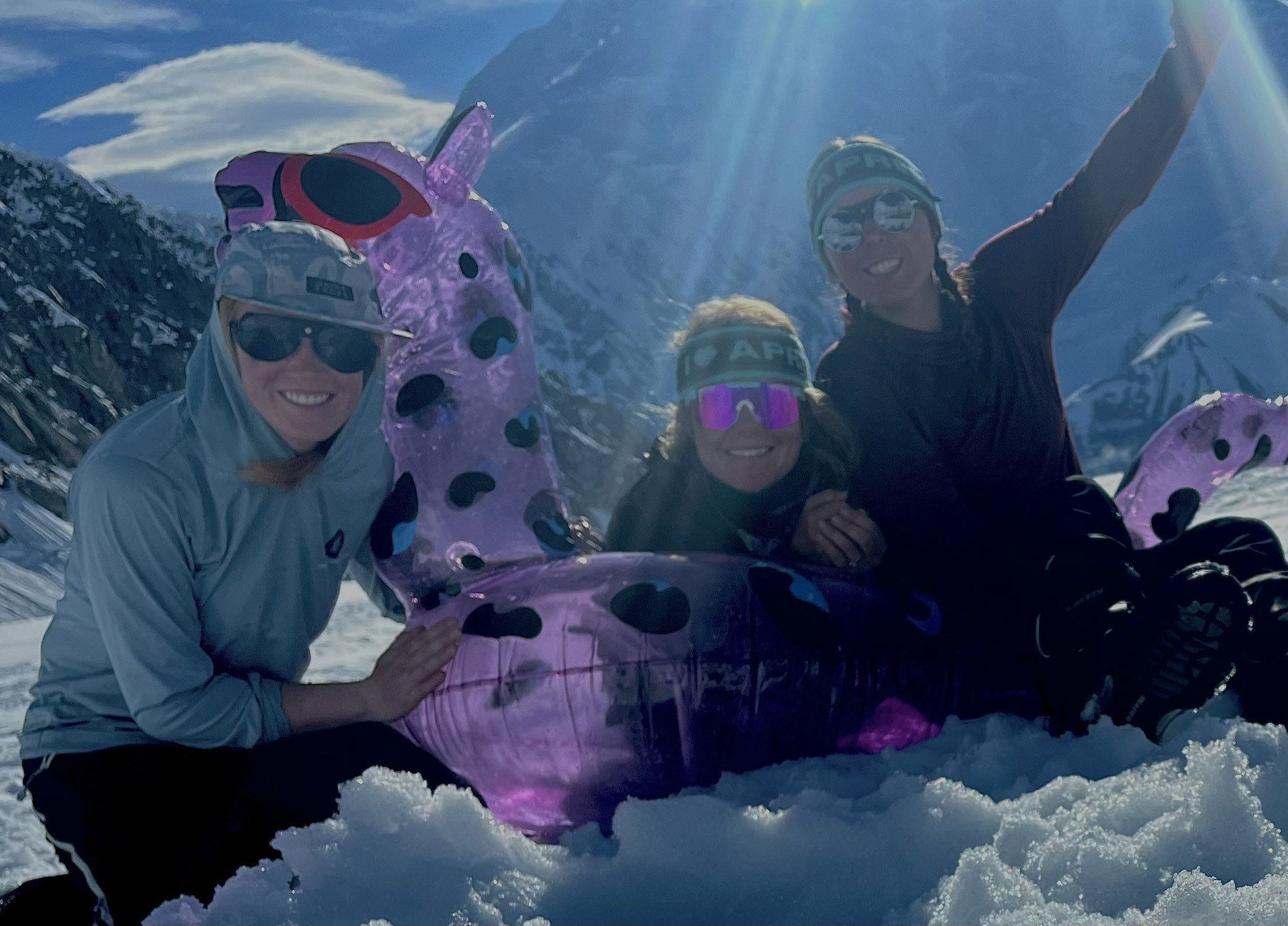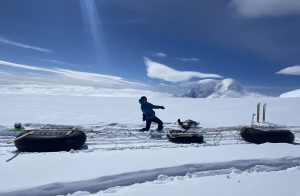
Characterizing the Englacial Stratigraphy at the Bottom of the Denali Ice Core, Alaska
Expedition Location: Denali National Park, Alaska
Expedition Dates: June 8, 2023 – July 14, 2023
Field Team Members: Emma Erwin (Phd Student, UMaine), Keegan Bellamy (MS student, UMaine), Claire Bicknell (BS student, Alaska Pacific University)
Funding Support: Dan & Betty Churchill Exploration Fund
Research Background:
Twin surface-to-bedrock ice cores recovered from Begguya (Mt. Hunter) in 2013 have produced a high-resolution hydroclimate history of the greater Alaska region for the last 1200 years (Winski et al., 2017, Winski et al., 2018, Osterberg et al., 2017). Carbon-14 data now confirm early Holocene-age ice in the bottom 10 m of the ~210 m core and the full stable isotope profile implies late Pleistocene, and possibly Eemian, ice near the bed (Winski et al., 2022; Fang et al., in prep). Stratigraphic continuity of the bottom 10 m remains uncertain and must be resolved to enable accurate interpretation of data. Currently, it is unclear whether or not we have a continuous paleoclimate record from the surface to bedrock, or if the deepest ice layers are folded over, thereby interrupting or truncating the paleoclimate Holocene record. The variability in stable isotopes near the base may represent a continuous record extending into the last glacial maximum or even the Eemian; or, there may be folded Holocene and Younger Dryas layering. Eemian basal ice would provide an unprecedented view of regional climatic conditions during a previous warm period with implications for a present-day analog for modern climate warming. In contrast, Younger Dryas ice could provide insight into a short-lived cold reversal. Unraveling these basal layers is critical for characterizing ice core records during periods of rapid climate change. The use of state-of-the-art radar systems at the ice core site, combined with new processing techniques, allows for a significant step forward towards interpretation of the full extent of the Denali ice core. In this study, we aim to address the following questions: 1) Is there stratigraphic continuity in the bottom 10 m of the Denali ice cores? 2) What is the chronology of basal proximal ice in the bottom 10 m of the Denali ice core?
Study Site:
This fieldwork was conducted in Denali National Park, Alaska on the Begguya (Mt. Hunter) summit plateau. The remote and high-altitude nature of this field site (~13,000 ft) requires an acclimatization period on the West Buttress of Denali prior to flying via helicopter to the Begguya summit plateau. Our team flew into Denali’s Base Camp (7,200 ft) on June 14th, spent a few days climbing up to Denali’s Camp II (11,000 ft), and remained there for over a week before returning to base camp. We waited out several storms until we were able to safely fly to the Begguya plateau on July 1, the first clear day since our arrival onto the ice. On the Begguya plateau, we endured several large storms of high winds and heavy snow. This limited the amount of science we were able to accomplish safely during this field season; nevertheless, all team members stayed safe and remained positive despite harsh conditions. The National Park Service and Talkeetna Air Taxi worked together to retrieve us from our high mountain field site and flew us out during a short weather window on the evening of July 9th. We spent the rest of the week sorting, cleaning, and repairing gear and equipment for use in future field work.




Methods:
Our team spent 27 days on the ice in Denali National Park. The majority of this time involved weathering storms at high altitude. Only about 3 days of our field season included enough breaks in the inclement weather to accomplish scientific work; the rest were spent hunkering, shoveling, and maintaining camp amidst the big mountain storms. Nevertheless, we were able to accomplish the primary objective of this field work: a fine-scale survey of the 2013 Denali ice core site with the Autonomous Phase Sensitive Radar (ApRES). This involved nearly 30 hours of concentrated work, moving the radar at 10 cm increments over a 150 m domain. The radar data will be processed in the coming months using Synthetic Aperture Radar (SAR) techniques to assess the englacial stratigraphy at the site with sub-meter resolution. Additionally, basal reflectors from the ApRES survey will be incorporated into the development of a three-dimensional ice flow model to further assess the deformation, flow history, and subsequent depth-age scale of the ice core site.
Acknowledgements:
This PhD dissertation research work would not have been possible without the critical support from multiple sources. Most importantly, this field season would not have been successful without the enduring optimism of its field assistants: Keegan Bellamy (University of Maine graduate student) and Claire Bicknell (Alaska Pacific University undergraduate student). Funding for this remote field work was provided by: the Dan & Betty Churchill Exploration Fund, the Cold Regions Research and Engineering Laboratory, the University of Washington, Phi Kappa Phi’s Graduate Research Grant, and NOLS (National Outdoor Leadership School). The mountaineering park rangers and helicopter pilots of Denali’s National Park Service provided crucial support for our team, as did Talkeetna Air Taxi’s pilots and staff.
References:
Osterberg, E. C., Winski, D. A., Kreutz, K. J., Wake, C. P., Ferris, D. G., Campbell, S., … & Birkel, S. (2017). The 1200 year composite ice core record of Aleutian Low intensification. Geophysical Research Letters, 44(14), 7447-7454.
Winski, D., Osterberg, E., Ferris, D., Kreutz, K., Wake, C., Campbell, S., … & Handley, M. (2017). Industrial-age doubling of snow accumulation in the Alaska Range linked to tropical ocean warming. Scientific reports, 7(1), 1-12.
Winski, D., Osterberg, E., Kreutz, K., Wake, C., Ferris, D., Campbell, S., … & Handley, M. (2018). A 400‐year ice core melt layer record of summertime warming in the Alaska Range. Journal of Geophysical Research: Atmospheres, 123(7), 3594-3611
Winski, D., Brooks, H., Kreutz, K., Osterberg, E., Wake, C., Schwikowski-gigar, M., …., & Korotkikh, E. “The 4.2ka event, early Holocene, and possible late Pleistocene North Pacific climate recorded in the Mt. Hunter (Denali) ice cores,” International Partnerships in Ice Core Sciences (IPICS) 3rd Open Science Conference, 2-7 October 2022, High-alpine ice cores, https://indico.psi.ch/event/6697/sessions/7040/attachments/22302/38886/65_Winski_D_poster.pdf

